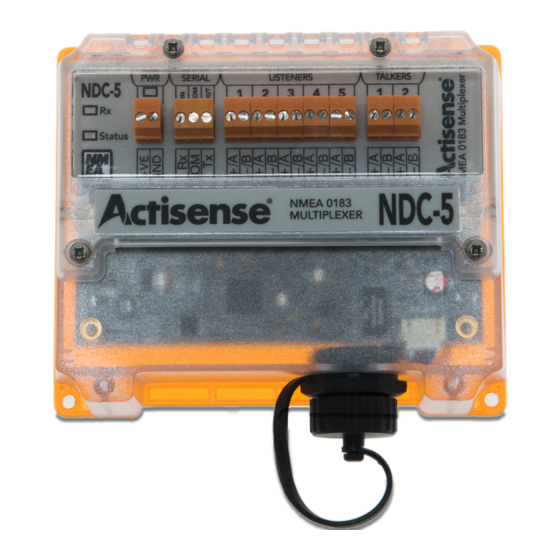
Actisense NMEA 0183 Information Sheet
Hide thumbs
Also See for NMEA 0183:
- Install & user manual (16 pages) ,
- Quick start manual (2 pages) ,
- Installation manual (12 pages)
Table of Contents
Advertisement
Quick Links
Advertisement
Table of Contents

Subscribe to Our Youtube Channel
Summary of Contents for Actisense NMEA 0183
- Page 1 The NMEA 0183 Information sheet Everything you wanted to know about NMEA 0183 (but were afraid to ask) Issue 1.50 Understanding the NMEA 0183 specification How to connect NMEA 0183 devices together How to understand NMEA 0183 sentence formats...
-
Page 2: Table Of Contents
The different versions of the NMEA 0183 standard Connecting a differential NMEA talker to other devices NMEA Listener device (1): Standard differential NMEA 0183 v2.0+ device NMEA Interface (2): PC with an opto-isolated input (via Actisense™ PC-OPTO-1) NMEA Listener device (3): Single-ended NMEA interface device Connecting a single-ended NMEA talker to other devices NMEA Listener device (1): Standard differential NMEA 0183 v2.0+ devices... -
Page 3: Important Notices
NMEA interfacing. Please report any errors, omissions or inaccuracies to Actisense - we intend this document to be a useful resource tool to installers new to NMEA 0183 and inevitably we may have missed out the vital piece of information that they may have required to achieve a working NMEA 0183 system. -
Page 4: Nmea 0183 Introduction
Note: potentially in disaster if valuable data such as navigation NMEA 0183-HS or NMEA 0183 v3 is in no way related to information is lost or corrupted so that it is incorrect and/or the new NMEA 2000 standard (as is incorrectly suggested misleading. -
Page 5: Connecting A Computer To Your Nmea 0183 System
(See the Actisense ground loop information sheet for more information). To safely interface to the NMEA 0183 system on a boat, it On the dialogue box (above), select 4800 Bits per second, is best to obtain an opto-isolated NMEA to RS232 adapter 8 Data bits, Parity “None”, Stop bits “1”, Flow control... -
Page 6: Example Data Using An Actisense Talker Device
Plus, all this data is supplied through just one NMEA 0183 port. The Actisense™ active depth sounder module (DST-2) has the same Digital Signal Processor unit, but can connect to any Triducer (Depth, Speed & Temperature), Biducer (Depth &... -
Page 7: Connecting Devices Together
“Listener” devices. So how can an older type NMEA device be connected The NDC-2 also allows for filtering of the NMEA 0183 data to a newer type device? Care is needed – it is possible to remove any unwanted data, and has a wide range of to damage or overload the output of a newer differential input / output Baud rates to match any NMEA device. -
Page 8: Connecting A Differential Nmea Talker To Other Devices
This device is a differential device conforming in full to To connect the device to the differential output, connect the NMEA 0183 v2.0 (or higher) standard, and connects ‘NMEA +/A’ to the device’s ‘NMEA’ input and ‘Ground’ to directly to the pins on the differential device. -
Page 9: Connecting A Single-Ended Nmea Talker To Other Devices
This device is a differential device conforming in full to the This device is a single ended device. The device is simply NMEA 0183 v2.0 (or higher) standard. Its “NMEA +/A” connected as “NMEA Out” to “(NMEA) In” and “Ground”... -
Page 10: Nmea 0183 Sentence Format
Actisense™ NMEA 0183 Sentence Format All NMEA 0183 data is sent in the form of text sentences, each beginning with a ‘$’ or ‘!’ symbol, and use commas to separate each part of the sentence. NMEA codes are plain ‘ASCII’ text, and have the following format: $yyXXX,………... -
Page 11: Dbt - Depth Below Transducer
Not all NMEA 0183 devices that output this sentence can Not all NMEA 0183 device that output this sentence can have their depth offset changed. In this case, the depth have their trip distance reset - in this case, a power reset offset will always be zero, or not included. -
Page 12: Contact Information
BH12 3PF Telephone: 01202 746682 (International : +44 1202 746682) Fax: 01202 746683 (International : +44 1202 746683) Actisense™ on the Web: For feedback, advice, support and product details E-mail: support@actisense.com Website: www.actisense.com Active Research on the Web: For specialist consultancy and customisation E-mail: support@activer.com...






Need help?
Do you have a question about the NMEA 0183 and is the answer not in the manual?
Questions and answers